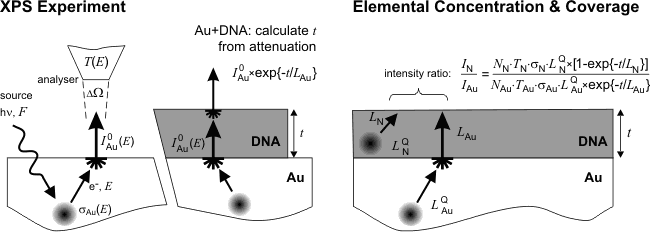X-ray Photoelectron Spectroscopy
X-ray Photoelectron Spectroscopy (XPS), also known as ESCA, is a surface analysis technique that uses an x-ray beam to eject electrons from a surface. The kinetic energies of the ejected electrons (photoelectrons) are then analyzed to produce a spectrum, in which photoelectron peaks coming from different chemical elements can be identified by their characteristic energies. The typical sample areas that can be analyzed are between 1 mm2 and 1 cm2, which makes XPS a useful technique for studying a wide variety of samples.

XPS survey spectrum of an oxidized InAs surface. The major XPS peaks are marked for In and As of the InAs substrate, as well as for C and O present on the surface. A series of As LMM Auger peaks appears between 200 and 400 eV.
Quantitative Interpretation of XPS Data
In the most general case, the "atomic percent" method is used to interpret XPS data, whereby the signal from each element is normalized against the total amount of all the detected elements, which is taken as 100%. The simplicity of the "atomic percent" interpretation can be considered both as a curse and as a blessing, depending on the system being analyzed. The main benefit of this method is that it always works and is never wrong, to the extent that the areas of all the elemental peaks in the spectrum have been determined correctly. However, taken on its own, e.g., without reference data from standard samples, the "atomic percent" composition is not particularly informative because non-uniform distribution of the different elements can strongly affect the corresponding "atomic percent" values (the apparent composition will be rich in elements that are closer to the surface).

Schematic outline of the quantitative XPS analysis procedure for a molecular film on gold.
(left) The intensities of XPS peaks measured from clean Au and Au+DNA samples are used to determine the thickness and uniformity of the DNA film.
(right) Absolute atomic concentrations of elements in the molecular film are determined from the standard XPS analysis formalism using theoretical values of electron attenuation lengths and known material parameters of gold.
Fortunately, more advanced XPS interpretation is possible for certain broad classes of samples, e.g., thin layers of organic molecules, polymers, or biomolecules supported on a substrate of simple and uniform composition, or thin oxide layers on metals and semiconductors. For common substrate materials (silicon, gold, aluminum, copper, silver) the corresponding material parameters (density, electron attenuation length) are well-known, allowing the interpretation of XPS data not only in terms of relative elemental concentrations, but also in terms of absolute numbers of atoms of the respective elements.
Software for Advanced Analysis of XPS Data
In the last decade, the computing power of desktop computers has increased sufficiently to allow incorporation of fundamental physical models into the software used to analyze and interpret XPS data. Particularly significant is the continued implementation of the state-of-the-art models and methods in publicly-available software, which is a marked improvement over the prior decades, when such implementation was limited to custom code written and utilized by individual researchers.
- Simulation of Electron Spectra for Surface Analysis (SESSA)
- NIST Electron Effective-Attenuation-Length Database (NIST SRD-82)
- NIST X-ray Photoelectron Spectroscopy Database
- Quantitative Analysis of Surfaces by Electron Spectroscopy (QUASES)
- Excellent software for fitting XPS data: Unifit
- Software for quantitative interpretation of XPS data: XPS MultiQuant
References
These links provide additional information about XPS and examples of quantitative surface analysis by XPS.
- Article about XPS on Wikipedia.
- The Electron Attenuation Length Revisited, review by A. Jablonski and C. J. Powell
Surf. Sci. Rep. 47, 33 (2002). DOI: 10.1016/S0167-5729(02)00031-6 - Quantitative Characterization of DNA Films by X-ray Photoelectron Spectroscopy (200 kB),
Langmuir 20, 429 (2004). - Quantification of Discrete Oxide and Sulfur Layers on Sulfur-Passivated InAs by XPS (320 kB),
Surf. Interface Anal. 37, 989 (2005). - Alkanethiols on Platinum: Multicomponent Self-Assembled Monolayers (405 kB),
Langmuir 22, 2578 (2006). - Self-Assembled Monolayers of Alkanethiols on InAs (1.3 MB),
Langmuir, 25, 12185 (2009). - Surface Composition, Chemistry, and Structure of Polystyrene Modified
by Electron-Beam-Generated Plasma, PDF (2.6 MB), Langmuir, 26, 8857 (2010).